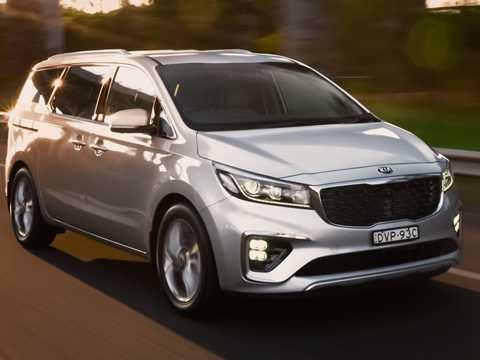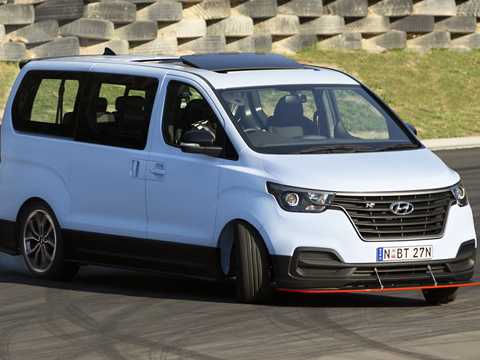Practicality and toughness. If you have a large family or run a seven-seat van for airport transfers, hotel or limousine services bet you rank those attributes highly.
Korean brand SsangYong has been strong on those two points across its entire range and no vehicle exhibits them better than the Stavic people-mover. SsangYong has just launched an all-new version of the Stavic which looks great, drives well and – here’s the clincher – is priced at $29,990.
Yep that’s tight, a massive seven-seat people mover with lots of space, comfort and a cargo area which is massive – even when all seats have people in them. Sounds just right for large families and commercial operators…and it is.
But the news gets better as SsangYong tells us there is an upscale luxo version of the Stavic on the way and it could be priced as low as $35,000. Many seven-seat arrivals start $10,000 north of that for their entry-level models.
SsangYong Stavic Overview
The ‘elephant in the room’ for the SsangYong Stavic is the previous model which…erm let’s say wasn’t the prettiest thing on four wheels. Well, forget that, the all-new model looks rather nice actually while combining the hallmark Stavic practicality and strength.
Currently only available in one handily-equipped model - carrying that remarkable $29,990 sticker – SsangYong Stavic is propelled by a powerful new 2.0-litre turbo-diesel with a five-speed automatic transmission and unusually driving the rear wheels.
Space is the ‘kicker’ for large families and commercial operators. In the SsangYong Stavic, you feel like you could put a set of stumps in the rear, grab a cricket ball and bowl a few overs from the front seats.
SsangYong Stavic Engine
SsangYong equips the Stavic with its new 2.0-litre, four-cylinder turbo-diesel engine. Euro 5 compliant for emissions (SsangYong is a big seller in many European markets like Britain and even Greece) the turbo 2.0-litre delivers maximum power of 114kW between 3400rpm and 4000rpm and peak torque of 360Nm is available between 1500rpm and 2800rpm.
Those figures outpunch the rival Hyundai iMax’s 100kW/343Nm 2.5-litre turbo-diesel and combine with SsangYong Stavic’s 2000kgs towing capacity to further reinforce its suitability as an airport transfer vehicle (many of which use trailers for additional luggage transport).
And we were pleasantly surprised by the refinement of the turbo-diesel. Even at freeway speeds or when cold in the morning the SsangYong Stavic was impressively quiet.
SsangYong Stavic The Interior
We’d like to give you a detailed report on life in the SsangYong Stavic’s second and third row seats. How one can luxuriate in the individual second row seats with adjustable arm rests and tray table to occupy those long hours on the Hume Highway.
How the third row seat’s impressive leg-room allowed us to stretch-out while taking-in the vistas varying from the sun at Sydney’s Cronulla Beach, through the fog-shrouded NSW Southern Highlands to the heavy rain on the outskirts of Melbourne.
But that’s not how family road trips work. Nope. As usual Dad spent the entire 10 hours behind the steering wheel (no reach adjustment but comfortable enough thanks to the relatively large dimensions of the front seats). Pleasingly the actual driving position is much improved over the previous Stavic with a more passenger car-like posture replacing the old truck-style upright position.
Like the previous model, the all-new SsangYong Stavic has centre-mounted instruments (nice modern graphics and well-lit) covering the majors (speed, engine temperature, trip meter and fuel-level) with warning lights in a small panel directly behind the steering wheel.
Centre console is the gear lever for the five-speed auto which, in sport mode, affords BMW-style changes up and down via neat buttons on the steering wheel. And, as you’d expect, there’s plenty of storage bins.
Audio is a CD/MP3 system with Bluetooth, USB and AUX port.
Second row seats are two individual buckets with arm rests and seat-back trays mounted in the back of the front seats. The third row has three seating positions and there are two ISOFIX child seat anchors.
And there is space, space and space with lots of room for people to get comfortable and easy access to all seats.
Overall there is a pleasing lift in quality of the trim materials throughout the Stavic compared to the previous generation with nice carpets as well.
SsangYong Stavic Exterior & Styling
There’s no doubt SsangYong has transformed the looks for the all-new Stavic. There are some distant cues to its predecessor but this time the rear-end is actually nicely styled. The modern front end softens things considerably compared to the previous model with contemporary headlights and nice use of chrome to deliver a degree of luxury and sophistication.
Overall the SsangYong Stavic is no shrinking violet – 5,130mm in length (wheelbase 3,000mm), 1,915mm in width and 1,815mm high this is a significant seven-seat van.
Like the previous Stavic, the all-new model doesn’t use sliding side doors – they open conventionally like a four-door sedan.
The rear-end is likewise a much more pleasing and sophisticated look but retains that massive, low-opening tailgate to make loading a snack.
SsangYong Stavic rides on 16-inch alloy wheels.
SsangYong Stavic On The Road
The rub-off of SsangYong’s association with Mercedes-Benz continues to pay dividends (the previous Stavic rode on a platform derived from an earlier generation E-Class ‘Benz chassis) and the all-new Stavic is sophisticated underneath with a double-wishbone front-end and multi-link rear.
Combine that chassis with nice power from that turbo 2.0-litre and the result is a nice drive – even when fully loaded with youngsters and holiday gear as we were on our trip from Sydney to Melbourne.
As we mentioned, the 2.0-litre turbo-diesel was impressively quiet and, when we got to tackle our high-speed mountain roads test loop, the SsangYong Stavic responded nicely with push-button manual shifts of the five-speeder and reasonable precision and balance in the twists. Our only points deduction came from the steering which while responsive, did seem to require more input than some rivals.
SsangYong Stavic Challenges
The combination of those plenty of turns lock-to-lock on the steering wheel, a 12.2-metre turning circle and no reversing camera meant maneuvering the SsangYong Stavic in our tight CBD car park couldn’t be rushed.
SsangYong Stavic Verdict
For families, hotel and airport transfer operators, the previous SsangYong Stavic had a lot going for it – massive interior space even when all seats were occupied, as tough as a month-old T-Bone and that fuel-sipping diesel. But it was hit big-time by the ugly stick.
Tah-dah! SsangYong has bounced back with an all-new Stavic which, like its predecessor, delivers on the practicality but this time is pleasant enough in the looks department. Mostly commendable in the driving dynamics and much more refined, the latest SsangYong Stavic mounts a compelling argument for those shopping in this segment who are tight on coin.
To be blunt, Australia’s new SsangYong distributor, Ateco Automotive, has really drawn a new line in the sand with the all-new Stavic priced at $29,990. That’s $10,000 – 10-grand!! – less than the directly comparable Hyundai iMax.
A shame we can’t give a direct report on life in the second and third row seats. But family road trips are often like that…Dad does all the driving!
SsangYong Stavic The Competition
SsangYong really has posed some serious questions with the all-new Stavic priced at $29,990. Sure, as always you do have to carefully cross-reference specifications and inclusions against rivals, but consider:
Hyundai iMax CRDI is $39,990 and its 100Nm/343Nm 2.5-litre turbo-diesel is outgunned by SsangYong’s 2.0-litre (114kW/360Nm). And the Stavic is more fuel-efficient (7.8l/100kms to 8.1l/100kms for the iMax).
Then it’s a step-up to the Kia Grand Carnival ($44,990 starting price for the 2.2-litre turbo-diesel), Mercedes-Benz Vito and Volkswagen Multivan (both starting at $49,990).
Toyota’s ever-green Tarago remains popular but isn’t available in diesel and starts at $48,990.
































